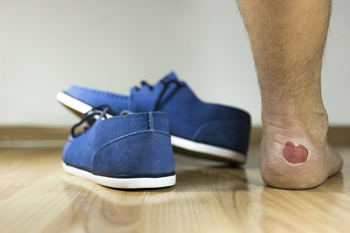
A blood blister is a raised section of skin filled with red fluid that begins as a light red color and becomes darker. It is similar to a blister caused by friction that fills with clear liquid. A blood blister will usually disappear in a week or two and should cause little concern. Usually, the pain associated with a blood blister comes from the action that initially caused it. A blood blister can form on the feet where the skin is pinched but does not break open. It can result from factors such as poorly fitting shoes that pinch the skin, sweaty feet that cause extra friction, or severe frostbite. People should wear well-fitting shoes and keep their feet dry to avoid blood blisters. If a blood blister develops, the area should be kept clean, and the blister should not be popped. If there is no apparent reason for the onset of a blood blister, if it does not clear up on its own, repeatedly returns, or if there are signs of infection, consult with a podiatrist who can diagnose any unusual or underlying problems and provide necessary treatment.
Blisters are prone to making everyday activities extremely uncomfortable. If your feet are hurting, contact Howard Kimmel, DPM of Buckeye Foot Care. Our doctor can provide the care you need to keep you pain-free and on your feet.
Foot Blisters
Foot blisters develop as a result of constantly wearing tight or ill-fitting footwear. This happens due to the constant rubbing from the shoe, which can often lead to pain.
What Are Foot Blisters?
A foot blister is a small fluid-filled pocket that forms on the upper-most layer of the skin. Blisters are filled with clear fluid and can lead to blood drainage or pus if the area becomes infected.
How Do Blisters Form?
Blisters on the feet are often the result of constant friction of skin and material, usually by shoe rubbing. Walking in sandals, boots, or shoes that don’t fit properly for long periods of time can result in a blister. Having consistent foot moisture and humidity can easily lead to blister formation.
Prevention & Treatment
It is important to properly care for the affected area in order to prevent infection and ease the pain. Do not lance the blister and use a Band-Aid to provide pain relief. Also, be sure to keep your feet dry and wear proper fitting shoes. If you see blood or pus in a blister, seek assistance from a podiatrist.
If you have any questions, please feel free to contact one of our offices located in Brook Park and Willoughby, OH . We offer the newest diagnostic and treatment technologies for all your foot care needs.
